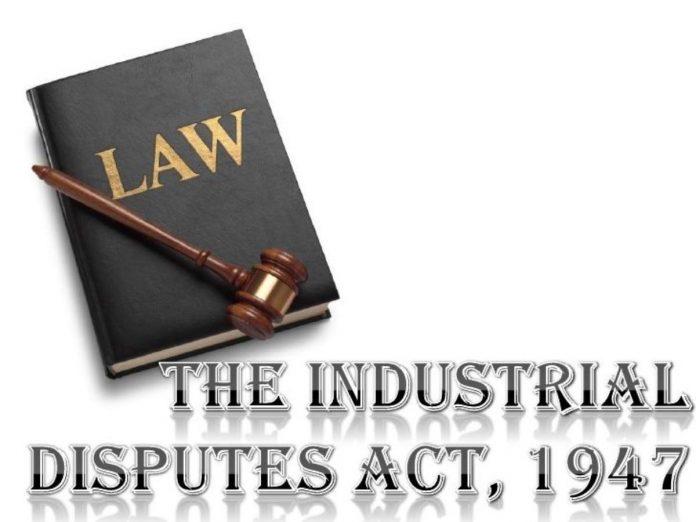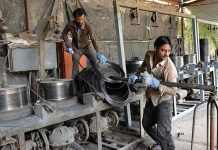This article is written by Jaya Jha of the Vivekananda Institute of Professional Studies, Delhi. This article deals with a comparative analysis of Section 10 of the Industrial Disputes Act, 1947 and its various components. It also touches briefly on the aspects of voluntary arbitration under Section 10A of the said Act.
This article has been published by Sneha Mahawar.
Table of Contents
Introduction
Industrial disputes can be a roadblock to the progress of any nation’s economy. To ensure a harmonious relationship between workers and employers, Section 10, a powerful provision that empowers the government to intervene and resolve conflicts through conciliation or adjudication, was incorporated into the Industrial Disputes Act, 1947. It serves as a vital tool in promoting the peaceful resolution of disputes in the workplace and safeguarding the interests of both workers and employers. Section 10 of the Industrial Disputes Act, 1947 deals with the procedure for the reference of disputes to the appropriate authority for adjudication.
The relationship between the workmen and the employee is very dependable despite many disagreements and disputes. This makes it important that they have a non-adversarial mode of dispute resolution. It outlines the process by which a dispute between an employer and a group of employees, or between employers and employees, can be referred to a third-party authority for resolution. The objective of Section 10 is to provide a legal framework for the resolution of industrial disputes in an orderly and peaceful manner. It seeks to prevent disruptions to industrial production and protect the interests of workers and employers alike. This article mainly deals with all the aspects of Section 10 in detail of the act and briefly discusses the scheme of voluntary arbitration mechanism provided in the act
What does Section 10 of the Industrial Disputes Act, 1947 say
Section 10 of the Industrial Disputes Act, 1947 empowers the appropriate government to intervene in an industrial dispute by referring it to a conciliation officer or a board for resolution. The Section states that if an employer or a group of employers, or any of their employees, or a group of employees, raises an industrial dispute, the appropriate Government may, by notification in the Official Gazette, refer the dispute to a conciliation officer for settlement. The conciliation officer then tries to resolve the dispute by bringing both parties to the table and facilitating negotiations. If the dispute is not resolved through conciliation, the government may refer it to a board for adjudication. This provision is aimed at promoting industrial peace and harmony by providing a mechanism for resolving disputes between workers and employers through peaceful means.
Who is an appropriate government under the Act
Under Section 10 of the Act, only the appropriate government has the power to refer disputes to the tribunal, court of inquiry, labour court, etc.
In the case of Prabhakar v. Joint Director Sericulture Department (2015), the Apex Court held that the aggrieved person cannot approach directly any labour court or any other body for adjudication until and unless the appropriate government has approved it, and the aggrieved person has to seek the reference of the dispute from the appropriate government.
In the case of Secretary, Indian Tea Association v. Ajit Kumar Barat (2000), the Supreme Court gives few points regarding the power of appropriate government
- Without determining from the facts and circumstances brought to its notice that an industrial dispute exists or is apprehended, the appropriate government would not be justified in referring to Section 10 of the Act.
- Order of the reference by the appropriate government will be considered an administrative order not judicial or quasi-judicial order.
- The party has the right and they are open to prove that the reference made by the appropriate government is not an industrial dispute under the industrial dispute act,1947.
Section 2(a), tells who will be the appropriate government under this Act:
- Central Government will be the appropriate government where:
- any industrial establishment is under the control of the central government or carried on by the central government; or,
- Railway Industry, banking and insurance company, a major port and mine and oil field.
The Supreme Court, in the case of Delhi International Airport (Pvt) Ltd v. Union of India (2011), held that the central government will be the appropriate government when the industry is under the central government, including industrial establishments related to the Airport Authority of India (AAI) and industries concerning air traffic.
- And for any other industrial dispute, the state government will be the appropriate government.
The Court in the case of Hindustan Aeronautics v. The Workmen (1975), held state government as an appropriate government of a separate unit of the company if that company is in the jurisdiction of the state, even if the company is functioning under the company head office which is situated in any other state.
Dispute settlement mechanisms under the Industrial Disputes Act, 1947
The dispute settlement mechanisms under the Industrial Disputes Act, 1947 provide a range of options for settling disputes between employers and employees in India. These mechanisms aim to promote the peaceful and expeditious resolution of disputes and prevent disruptive industrial action such as strikes and lockouts. The mechanisms provide a framework for resolving disputes in a fair and impartial manner, with the involvement of neutral third parties where necessary and due consideration for the interests of both employers and employees.
Sections 10 and 10A of the Act provide the dispute settlement mechanism.
Power of the appropriate government to refer industrial disputes to the concerned authority
Section 10 of the Industrial Disputes Act, 1947 gives the remedies and explains under what circumstances and when the appropriate government can refer to the labour court, tribunal, and court of inquiry.
In the case of State of Madras v. C.P. Sarthy (1953), the Supreme Court held that the parties to the dispute do not have direct access, and the reference made by the government is the mode through which the parties can approach the judicial or quasi-judicial forum. Further, the Court said that the reference power has the utmost importance under the Industrial Dispute Act, 1947 as the main object of the Act is to settle the dispute and establish industrial peace.
According to Section 10(1), the appropriate government when it thinks that a particular dispute is an industrial dispute or it apprehends it to be an industrial dispute then it may in writing
- Refer to the court of inquiry;
- If that dispute is related or seems to connect with the matter concerning the Second Schedule of the Industrial Disputes Act,1947 the appropriate government will refer the matter to the labour court.
- If the dispute concerning the matter is given in the Second and Third Schedule of the Act, the appropriate government will refer the dispute to the tribunal. But where the matter is related to the Third Schedule and that dispute is not affecting more than 100 workmen, the appropriate government, if it so thinks fit, can refer the dispute to the labour court.
The Supreme Court in the case of Steel Authority of India v. Union of India (2006) answered whether contractual labour should be abolished. The Labour Court held that contractual labour should be abolished. Further, the Apex Court held that this question should be decided by the central government, as it is the appropriate government in this domain and not the labour court.
National tribunal
Section 10(1A) tells us when the dispute should be sent to the national tribunal. Only the central government has the power to refer the dispute to the national tribunal, and it will be irrelevant whether the central government is the appropriate government for that industry or not. The central government will refer the dispute to the national tribunal in writing if in the government’s opinion the dispute
- It is of national importance;
- Or, by default of dispute nature involves two or more states or the industry establishment is situated in more than one state.
Section 10(2) gives power to the parties, saying that if they jointly or individually apply for the reference, the appropriate government shall refer it if it is satisfied.
Section 10(6) says that when any matter is referred to a national tribunal by virtue of Section 10(1A), no labour court or tribunal will have any jurisdiction to adjudicate any matter that is before the national tribunal, and accordingly:
- If the matter referred before the national tribunal is pending before the labour court or tribunal then it shall be deemed to be quashed on the reference to the national tribunal from the labour court or the tribunals.
- The appropriate government shall not refer as it is not lawful for the government to refer the adjudication matters before the national tribunal while the proceeding is pending related to that matter before the national tribunal to any labour court or tribunals.
Power to prohibit and put limitations by the appropriate government
Section 10(3) says that during the time of reference for the industrial dispute by the appropriate government, the government may issue a notice to prohibit the strike, lockout, etc. that is going on because of the dispute.
The Supreme Court in the case of Delhi Administration, Delhi v. Workmen of Edward Keventers (1978) expressed two important conditions which are necessary to make Section 10(3) applicable:
- “There must be an industrial dispute existing and such an existing dispute must have been referred to a Board, Labour Court, Tribunal, or National Tribunal under this section, namely, Section 10(1). Section 10 stands as a self-contained Code as it were so far as this subject matter is concerned. The prohibitory power springs into existence only when such dispute has been made the subject of reference under Section 10(1).
- Secondly, such a dispute must have been already referred for adjudication. Then, and then alone, the power to prohibit in respect of such referred dispute can be exercised.”
In the case of Madura Coats Employees v. State of Bihar (2017), the Patna High Court held that a conjoint reading of Sections 10(3) and 26(2) of the Act provides that the penal offence mentioned in Section 26(2) will only be applicable when reference by the appropriate government prohibiting the strike and lock-out is pending before the concerned authority. The Court further observed that if no such order or reference is there then the offence under Section 26(2) will not be applicable.
Limitations on adjudication proceedings
Section 10(4) puts limitations on the labour court, national tribunal, etc., and gives the scope of adjudication proceedings. When the appropriate government refers the industrial dispute by subsequent order to the concerned authority mentioned in Section 10 and also specifies the points of adjudication, the concerned court or tribunal should confine itself to those adjudication points only.
The Supreme Court in the case of National Council for Cement and Building Materials v. State of Haryana (1996) observed that Section 10(4) limits the jurisdiction of the adjudicatory tribunals and that jurisdiction is confined only to the points which were referred to in the matter by the appropriate government.
According to Section 10(5), the appropriate government is allowed to include any other establishment, group, or class of establishments of similar nature that are likely to be interested in or affected by the issue, either at the time of referring or at any time before the submission of the award.
Such inclusion is acceptable regardless of whether there are conflicts or apprehensions of conflicts at the time the establishment, group, or class of establishments is included. The appropriate government must have exclusive discretion to determine whether or not the dispute is of such a kind that any other establishment, group, or class of establishments of a similar nature is likely to be interested in or impacted by such a dispute. The appropriate government may come to this conclusion without receiving an application from another party.
Lapse of the matter
Section 10(8) says that no industrial dispute will lapse merely by the death of one of the parties to it, and the labour courts, national tribunals, and tribunals will pass the award and submit it to the appropriate government.
In the case of Satish Sharma v Union of India (2002), the Rajasthan High Court held that when the dispute is still existing and it has been not raised and it got a delay in raising, then reference that dispute can not be only refused on the ground that dispute has been delayed
Time frame for settlement of the dispute
Section 10(2A) of the Industrial Disputes Act, 1947 provides the time frame for settling the dispute.
The dispute was referred by the appropriate government to the labour court, tribunals, and national tribunal, and then, of course, the concerned authorities will have to settle the industrial dispute within the concerned time.
According to this Section, when the dispute concerns an individual workman, the time frame to settle the dispute is 3 months. Disputes should be resolved in at most three months.
According to Section 2(s), workman means any person who is skilled, unskilled, technical, manually, operationally, clerically, supervisory, etc. and hired for the reward in the industry, and the contract of the terms of employment can be implied or expressed.
And further for the dispute referring to the concerned authority workmen means any person who is being terminated, dismissed, discharged, etc.
Section 2(s) excludes “air force-governed persons, police, etc. from the definition of workmen”.
Further, Section 10(2A) provides that if parties to the dispute, according to the provisions of the Act, jointly ask for an extension of time from the labour court, tribunals, and national tribunals, then the concerned authorities mentioned in Section 10 can extend the time as they deem fit, and the reason for the extension should be recorded in writing. Computation of the extension period shall exclude the period where the proceedings before the labour court, tribunals, or national tribunals are being stayed by the civil court in the form of an interim order, injunction, etc.
This Section also says that the proceedings before the authorities mentioned in this Section will not lapse only because the time provided by them has expired.
All about Section 10 A: recourse to arbitration
The Industrial Disputes Act offers us numerous ways to recognise industrial disputes and also strategies to resolve them, and one of them is voluntary arbitration under Section 10A of the Act. This Section was added in 1956.
In the case of Karnal Leather Karamchari v. Liberty Footwear Company (1989), the Supreme Court observed that arbitration is one of the most effective and good ways to address and settle a dispute.
The Bombay High Court in the case of General Manager, Western Coalfields Ltd v. Sumit Mullick and Ors (2012) held that the remedies mentioned in Sections 10 and 10A are alternatives to each other, and if an agreement between the parties as per Section 10A for arbitration is being made, then the appropriate government can not refer the dispute to any of the authorities mentioned in Section 10 of the Act.
According to Section 10A, before the appropriate government refers the matter to the labour courts or tribunals, the parties to the industrial dispute may refer the dispute to arbitration in a written agreement.
Further Subsection 1A of Section 10A says that when an even number of arbitrators is being appointed, one umpire should also be elected so that when the even number of arbitrators give an opinion in the same different ratio, the umpire’s decision should prevail while passing the award.
Section 10A(3) says that the agreement to arbitrate must be given to the appropriate government, which must ensure it is published in the official gazette within one month of receiving it.
Section 10A(3A) mentions that the government must also make sure that parties who are interested in the dispute but are not parties to the agreement have an opportunity to present their matter before the arbitral tribunal. A notification to this effect must be issued according to Section 10A(3).
The arbitrators who were appointed by the parties will investigate the disputed matter, and the award that the arbitrator will pass shall be submitted to the appropriate government. The award should be signed by all the arbitrators as mentioned in Section 10A(4).
Where a notification under Section 10A(3A) has been issued to all parties, the government can prohibit the continuation of strikes or lock-outs that might have existed as described in Section 10A(4A).
The Supreme Court in the case of Rohtas Industries v. Rohtas Industries Staff Union (1976) held that the decision of the arbitrator appointed by the parties under Section 10A can be binding on the non-parties who are related to the parties in the agreement of the arbitration and that it was amenable to the jurisdiction of the High Courts under Article 227 of the Indian Constitution as these tribunals formed an extension of the sovereign justice system.
Conclusion
In conclusion, Sections 10 and 10A of the Industrial Disputes Act, 1947 play a vital role in ensuring the speedy resolution of industrial disputes in India. While Section 10 empowers the appropriate government to refer a dispute for conciliation, Section 10A provides for voluntary arbitration as an alternative method for dispute resolution. Both provisions are aimed at promoting industrial peace and harmony by encouraging parties to resolve disputes amicably and without resorting to strikes or lockouts. It is important to note, however, that the effectiveness of these provisions depends on the willingness of both parties to engage in the conciliation or arbitration process in good faith. With this in mind, it is essential that employers and workers approach the resolution of disputes with a spirit of cooperation and mutual understanding, in order to ensure the continued growth and development of India’s industrial sector.
Frequently Asked Questions
Is the decision by the arbitrator under Section 10A subject to judicial review?
Awards passed by the arbitrator are quasi-judicial and they can be challenged in the high courts. The Court in the case of The Engineering Mazdoor Sabha v. The Hind Cycles (1962) said that “The decisions of the arbitrators to whom industrial disputes are voluntarily referred under Section 10A of the Act are quasi-judicial decisions and they amount to determinations or orders under Article 136(1).”
Is it possible to challenge an award passed by the industrial tribunals after it becomes enforceable?
Yes, it is possible to challenge an award passed by the industrial tribunals after it becomes enforceable. The Supreme Court held in Bharat Bank Ltd. v. Employees of The Bharat Bank Ltd. (1950) that even though the Industrial Tribunal is not a court in the traditional sense because it performs quasi-judicial duties, it is still subject to the overriding jurisdiction under Article 136 of the Constitution, and it set aside the award made by the industrial tribunal.
What are the types of industrial disputes?
An industrial dispute can broadly be categorised into two parts:
Disputes related to rights mean disputes relating to the application or interpretation of an existing agreement or contract of employment.
Disputes related to interest relate to claims made by employees or suggestions made by management regarding the terms and conditions of employment.
References
- https://papers.ssrn.com/sol3/papers.cfm?abstract_id=3385403
- https://www.mondaq.com/india/employee-rights-labour-relations/629148/indian-industrial-disputes-act-1947
- http://www.penacclaims.com/wp-content/uploads/2021/01/Rakshita-Data.pdf
Students of Lawsikho courses regularly produce writing assignments and work on practical exercises as a part of their coursework and develop themselves in real-life practical skills.
LawSikho has created a telegram group for exchanging legal knowledge, referrals, and various opportunities. You can click on this link and join:
Follow us on Instagram and subscribe to our YouTube channel for more amazing legal content.
 Serato DJ Crack 2025Serato DJ PRO Crack
Serato DJ Crack 2025Serato DJ PRO Crack













 Allow notifications
Allow notifications



